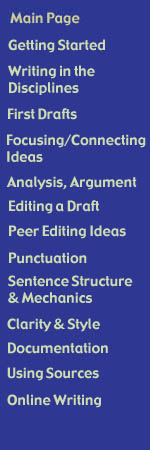

Pre-writing 
by Melanie Dawson
(printable version here)
Often the hardest part of developing a thesis and writing an effective paper is simply getting started. To help yourself formulate and organize ideas, a writer should try pre-writing. Pre-writing is a group of various methods that can help a writer get ideas down on a paper as they think of them, as well as helping the writer approach topics from different perspectives. The purpose of pre-writing is not to ensure everything is said with the exactly right words or in precise academic language.Pre-writing can help spark creativity, draw unexpected connections, and offer an unrestricted, comfortable space to build confidence with writing.
Cubing
Cubing is a writing exercise and a useful prewriting technique, like clustering, that helps a writer develop and expand upon ideas. Consider a cube. It might be helpful to pick up a book, or any other object with 6 sides. As the writer turns the object over, they see a different side and a different perspective of the same object each time. Cubing, when writing a paper, works much the same way. By challenging the writer to approach an topic from many different angles, it helps a writer come up with new ideas as well as predicting possible counter arguments.
Here are some guidelines:
- Time the writing with a clock or timer so that all six aspects of the topic are covered for equal amounts of time.
- Try to write about all six perspectives or sides. Even if the writer can only get 2 or 3 initially, thatís ok. The purpose of this exercise is to practice approaching topics from different angles.
- This exercise isn't about quality of content or precision of word choice. A writer shouldn't worry about covering one aspect more than another, simply allowing their observations to flow unihibited.
- Even if a writer thinks they know what their topic and thesis statement will be, they should try cubing for a few minutes. They may discover a new "angle" for the paper and create new avenues of discussion that will give depth to the argument. Cubing may also help determine the most interesting aspect of the topic. This physical metaphor can then provide a strong focus for writing a paper.
Freewriting: A Way Around Writer's Block
- Begin with a blank computer screen and a watch, or the clock on the computer. Try not to use the phone clock, as it can be too distracting. Handwriting is fine too-freewriting involves generating words, not correcting them or getting just the right word.
- Set a time. Try one, five, or ten minutes. Longer times may not be that productive since free writing is a "warm up" for more focused writing.
- Begin to type or write about anything that occurs. Don't stop until the time is up.
- Then review what's written. Do any words stand out? Ideas that might work for the next project?
- Put a topic at the top of a blank page.
- Set a time limit and begin free writing. This time, write down things that seem to be related to the topic. Don't worry about order of ideas or grammatical correctness. Don't worry if the ideas seem to be digressions. This is about generating ideas, not producing a finished work.
- When time is up, look over what is written. Pull out ideas and phrases that can be used later.
- Practice putting the freewriting into outline form. If you were to use the writing to begin a paper, which points would you make first? Second? (More practice with Outlines)
Freewriting is one of our Consultants' favorite techniques for helping writers who cannot get started. Freewriting is analogous to the warm up you might do before exercising.
There is no "correct" way to freewrite, so try a variation of these steps:
Focused freewriting follows the same process but begins with a topic:
Back to 'Getting Started'
Writer's Web | Writing Center | Make
an Appointment | Library
Copyright Info
Checked & proofread, fall 2018, Griffin Myers, Writing Consultant